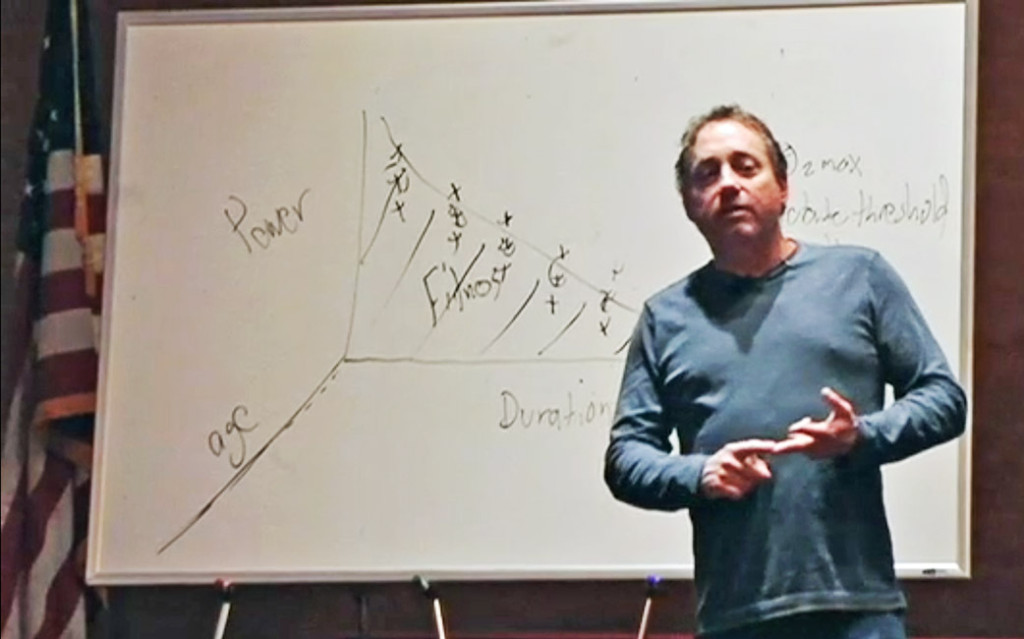CrossFit begins with a belief in fitness!
The aim of CrossFit is to forge a broad, general and inclusive fitness. We have sought to build a program that will best prepare trainees for any physical contingency — not only for the unknown, but for the unknowable. After looking at all sport and physical tasks collectively, we asked what physical skills and adaptations would most universally lend themselves to performance advantage. Capacity culled from the intersection of all sports demands would quite logically lend itself well to all sport. In sum, our specialty is not specializing.
CrossFit is many things
Primarily, it’s a fitness regimen developed by Coach Greg Glassman over several decades. He was the first person in history to define fitness in a meaningful, measurable way (increased work capacity across broad time and modal domains). CrossFit itself is defined as that which optimizes fitness (constantly varied functional movements performed at relatively high intensity). CrossFit is also the community that spontaneously arises when people do these workouts together. In fact, the communal aspect of CrossFit is a key component of why it’s so effective.
We offer the world’s most useful definition of fitness
Increased work capacity across broad time and modal domains. Capacity is the ability to do real work, which is measurable using the basic terms of physics (force, distance and time). Life is unpredictable (much more so than sport) so real world fitness must be broad and not specialized, both in terms of duration and type of effort (time and modal domains).
The magic is in the movements
All of CrossFit’s workouts are based on functional movements. These are the core movements of life, found everywhere, and built naturally into our DNA. They move the largest loads the longest distances so they are ideal for maximizing the amount of work done in the shortest time (intensity).
By employing a constantly-varied approach to training, these functional movements at maximum intensity (relative to the physical and psychological tolerances of the participant), lead to dramatic gains in fitness. Intensity is essential for results and is measurable as work/time. The more work you do in less time, the more intense the effort.
In implementation, CrossFit is, quite simply, the “sport of fitness.” We’ve learned that harnessing the natural camaraderie, competition and fun of sport or game yields an intensity that cannot be matched by other means. The late Col. Jeff Cooper observed, “the fear of sporting failure is worse than the fear of death.” It is our observation that men will die for points. Using whiteboards as scoreboards, keeping accurate scores and records, running a clock, and precisely defining the rules and standards for performance, we not only motivate unprecedented output, but derive both relative and absolute metrics at every workout. This data has important value well beyond motivation.
While it challenges the world’s fittest, the CrossFit program is designed for universal scalability, making it the perfect application for any committed individual, regardless of experience. We’ve used our same routines for elderly individuals with heart disease and cage fighters one month out from televised bouts. We scale load and intensity; we don’t change programs.
The needs of Olympic athletes and our grandparents differ by degree, not kind. Our hunters, skiers, mountain bike riders and housewives have found their best fitness from the same regimen.
CrossFit is a core strength and conditioning program centered upon constantly varied, functional movements performed at a (relatively) high intensity. Functional movements are those that mimic & reproduce natural efforts seen in everyday life, like squatting, standing, throwing, jumping, pushing, pulling, & running. CrossFit is not a specialized fitness program but a deliberate attempt to optimize competency in each of ten recognized fitness domains.
10 Fitness Domains:
- Endurance
Endurance The ability of body systems to gather, process, and deliver oxygen (cardiovascular/respiratory endurance). - Stamina
The ability of body systems to process, deliver, store, and utilize energy. (capacity to maintain repetitive muscular movements) - Strength
The ability of a muscular unit, or combination of muscular units, to apply force. - Flexibility
The ability to maximize the range of motion at a given joint. - Power
The ability of a muscular unit, or combination of muscular units, to apply maximum force in minimum time. - Speed
The ability to minimize the time cycle of a repeated movement. - Coordination
The ability to combine several distinct movement patterns into a single distinct movement. - Agility
The ability to minimize transition time from one movement pattern to another. - Balance
The ability to control the placement of the body’s center of gravity in relation to its support base. - Accuracy
The ability to control movement in a given direction or at a given intensity.
What About Nutrition?
World-Class Fitness in 100 Words:
Eat meat and vegetables, nuts and seeds, some fruit, little starch and no sugar. Keep intake to levels that will support exercise but not body fat. Practice and train major lifts: Deadlift, clean, squat, presses, C&J, and snatch. Similarly, master the basics of gymnastics: pull-ups, dips, rope climb, push-ups, sit-ups, presses to handstand, pirouettes, flips, splits, and holds. Bike, run, swim, row, etc, hard and fast. Five or six days per week mix these elements in as many combinations and patterns as creativity will allow. Routine is the enemy. Keep workouts short and intense. Regularly learn and play new sports.
-Greg Glassman

